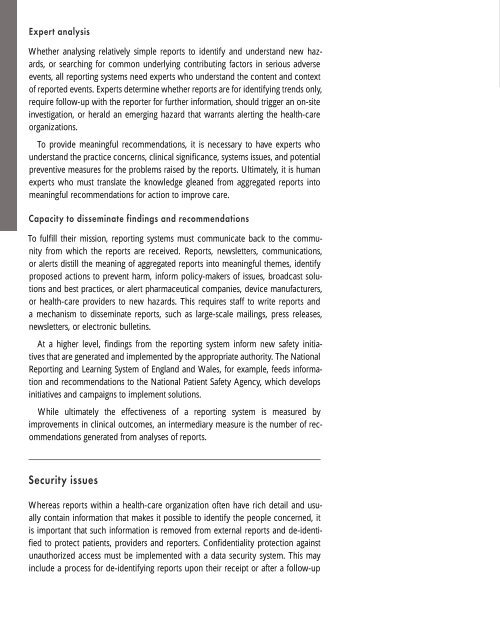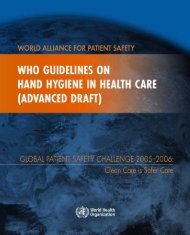Adverse event reporting.pdf
Adverse event reporting.pdf
Adverse event reporting.pdf
Create successful ePaper yourself
Turn your PDF publications into a flip-book with our unique Google optimized e-Paper software.
Expert analysis<br />
Whether analysing relatively simple reports to identify and understand new hazards,<br />
or searching for common underlying contributing factors in serious adverse<br />
<strong>event</strong>s, all <strong>reporting</strong> systems need experts who understand the content and context<br />
of reported <strong>event</strong>s. Experts determine whether reports are for identifying trends only,<br />
require follow-up with the reporter for further information, should trigger an on-site<br />
investigation, or herald an emerging hazard that warrants alerting the health-care<br />
organizations.<br />
To provide meaningful recommendations, it is necessary to have experts who<br />
understand the practice concerns, clinical significance, systems issues, and potential<br />
pr<strong>event</strong>ive measures for the problems raised by the reports. Ultimately, it is human<br />
experts who must translate the knowledge gleaned from aggregated reports into<br />
meaningful recommendations for action to improve care.<br />
Capacity to disseminate findings and recommendations<br />
To fulfill their mission, <strong>reporting</strong> systems must communicate back to the community<br />
from which the reports are received. Reports, newsletters, communications,<br />
or alerts distill the meaning of aggregated reports into meaningful themes, identify<br />
proposed actions to pr<strong>event</strong> harm, inform policy-makers of issues, broadcast solutions<br />
and best practices, or alert pharmaceutical companies, device manufacturers,<br />
or health-care providers to new hazards. This requires staff to write reports and<br />
a mechanism to disseminate reports, such as large-scale mailings, press releases,<br />
newsletters, or electronic bulletins.<br />
At a higher level, findings from the <strong>reporting</strong> system inform new safety initiatives<br />
that are generated and implemented by the appropriate authority. The National<br />
Reporting and Learning System of England and Wales, for example, feeds information<br />
and recommendations to the National Patient Safety Agency, which develops<br />
initiatives and campaigns to implement solutions.<br />
While ultimately the effectiveness of a <strong>reporting</strong> system is measured by<br />
improvements in clinical outcomes, an intermediary measure is the number of recommendations<br />
generated from analyses of reports.<br />
Security issues<br />
Whereas reports within a health-care organization often have rich detail and usually<br />
contain information that makes it possible to identify the people concerned, it<br />
is important that such information is removed from external reports and de-identified<br />
to protect patients, providers and reporters. Confidentiality protection against<br />
unauthorized access must be implemented with a data security system. This may<br />
include a process for de-identifying reports upon their receipt or after a follow-up
















